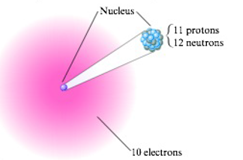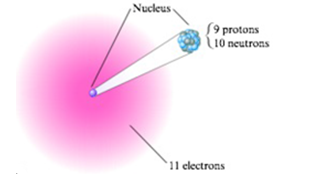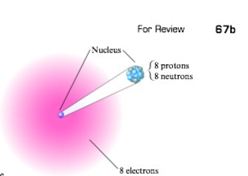
Chemistry
9th Edition
ISBN: 9781133611097
Author: Steven S. Zumdahl
Publisher: Cengage Learning
expand_more
expand_more
format_list_bulleted
Concept explainers
Textbook Question
Chapter 2, Problem 59E
Write the symbol of each atom using the
- a.

- b.

- c.

Expert Solution & Answer
Want to see the full answer?
Check out a sample textbook solution
Students have asked these similar questions
Identifying the major species in weak acid or weak base equilibria
The preparations of two aqueous solutions are described in the table below. For each solution, write the chemical formulas of the major species present at
equilibrium. You can leave out water itself.
Write the chemical formulas of the species that will act as acids in the 'acids' row, the formulas of the species that will act as bases in the 'bases' row, and the
formulas of the species that will act as neither acids nor bases in the 'other' row.
You will find it useful to keep in mind that NH3 is a weak base.
acids: ☐
1.8 mol of HCl is added to
1.0 L of a 1.0M NH3
bases: ☐
solution.
other: ☐
0.18 mol of HNO3 is added
to 1.0 L of a solution that is
1.4M in both NH3 and
NH₁Br.
acids:
bases: ☐
other: ☐
0,0,...
?
000
18
Ar
B
1
Using reaction free energy to predict equilibrium composition
Consider the following equilibrium:
2NH3 (g) = N2 (g) +3H₂
—N2 (g) AGº = 34. kJ
Now suppose a reaction vessel is filled with 4.19 atm of ammonia (NH3) and 9.94 atm of nitrogen (N2) at 378. °C. Answer the following questions about this
system:
rise
Under these conditions, will the pressure of NH 3 tend to rise or fall?
☐ x10
fall
Х
Is it possible to reverse this tendency by adding H₂?
In other words, if you said the pressure of NH 3 will tend to rise, can that
be changed to a tendency to fall by adding H₂? Similarly, if you said the
pressure of NH3 will tend to fall, can that be changed to a tendency to
rise by adding H₂?
If you said the tendency can be reversed in the second question, calculate
the minimum pressure of H₂ needed to reverse it.
Round your answer to 2 significant digits.
yes
no
atm
00.
18
Ar
무ㅎ
?
Identifying the major species in weak acid or weak base equilibria
The preparations of two aqueous solutions are described in the table below. For each solution, write the chemical formulas of the major species present at
equilibrium. You can leave out water itself.
Write the chemical formulas of the species that will act as acids in the 'acids' row, the formulas of the species that will act as bases in the 'bases' row, and the
formulas of the species that will act as neither acids nor bases in the 'other' row.
You will find it useful to keep in mind that HF is a weak acid.
2.2 mol of NaOH is added to
1.0 L of a 1.4M HF
solution.
acids:
П
bases:
Х
other: ☐
ப
acids:
0.51 mol of KOH is added to
1.0 L of a solution that is
bases:
1.3M in both HF and NaF.
other: ☐
00.
18
Ar
Chapter 2 Solutions
Chemistry
Ch. 2 - Use Daltons atomic theory to account for each of...Ch. 2 - What evidence led to the conclusion that cathode...Ch. 2 - What discoveries were made by J. J. Thomson, Henri...Ch. 2 - Consider Ernest Rutherfords -particle bombardment...Ch. 2 - Do the proton and the neutron have exactly the...Ch. 2 - What is the distinction between atomic number and...Ch. 2 - Distinguish between the terms family and period in...Ch. 2 - The compounds AlCl3, CrCl3, and ICl3 have similar...Ch. 2 - Prob. 9RQCh. 2 - How would you name HBrO4, KIO3, NaBrO2, and HIO?...
Ch. 2 - Which of the following is true about an individual...Ch. 2 - How would you go about finding the number of chalk...Ch. 2 - These questions concern the work of J. J. Thomson....Ch. 2 - Prob. 4ALQCh. 2 - You have a chemical in a sealed glass container...Ch. 2 - The formula of water is If-O. Which of the...Ch. 2 - You may have noticed that when water boils, you...Ch. 2 - One of the best indications of a useful theory is...Ch. 2 - Prob. 9ALQCh. 2 - Prob. 10ALQCh. 2 - Label each of the following as an atomic element,...Ch. 2 - Prob. 12ALQCh. 2 - Prob. 13ALQCh. 2 - Prob. 14ALQCh. 2 - Which of tire following explain how an ion is...Ch. 2 - What refinements had to be made in Daltons atomic...Ch. 2 - When hydrogen is burned in oxygen to form water,...Ch. 2 - The two most reactive families of elements are the...Ch. 2 - Explain the law of conservation of mass, the law...Ch. 2 - Section 2.3 describes the postulates of Daltons...Ch. 2 - The contributions of J. J. Thomson and Ernest...Ch. 2 - Prob. 22QCh. 2 - The number of protons in an atom determines the...Ch. 2 - If the volume of a proton were similar to the...Ch. 2 - Prob. 25QCh. 2 - List some characteristic properties that...Ch. 2 - Consider the elements of Group 4A (the carbon...Ch. 2 - Distinguish between the following terms. a....Ch. 2 - Label the type of bonding for each of the...Ch. 2 - The vitamin niacin (nicotinic acid. C6H5NO2) can...Ch. 2 - Prob. 31QCh. 2 - Prob. 32QCh. 2 - When mixtures of gaseous H2 and gaseous Cl2 react,...Ch. 2 - Observations of the reaction between nitrogen gas...Ch. 2 - A sample of chloroform is found to contain 12.0 g...Ch. 2 - A sample of H2SO4 contains 2.02 g of hydrogen,...Ch. 2 - Hydrazine, ammonia, and hydrogen azide all contain...Ch. 2 - Consider 100.0-g samples of two different...Ch. 2 - The three most stable oxides of carbon ire carbon...Ch. 2 - Two elements. R and Q, combine to form two binary...Ch. 2 - In Section 1.1 of the text, the concept of a...Ch. 2 - In a combustion reaction, 46.0 g of ethanol reacts...Ch. 2 - Early tables of atomic weights (masses) were...Ch. 2 - Indium oxide contains 4.784 g of indium for every...Ch. 2 - Prob. 45ECh. 2 - If you wanted to make an accurate scale model of...Ch. 2 - In an experiment it was found that the total...Ch. 2 - A chemist in a galaxy tar, far away performed the...Ch. 2 - What are the symbols of the following metals:...Ch. 2 - What are the symbols of the following nonmetals:...Ch. 2 - Give the names of the nonmetals that correspond to...Ch. 2 - a. Classify the following elements as metals or...Ch. 2 - a. List the noble gas elements. Which of the noble...Ch. 2 - For each of the following sets of elements, label...Ch. 2 - Prob. 56ECh. 2 - Prob. 57ECh. 2 - Write the atomic symbol (ZAX) for each of the...Ch. 2 - Write the symbol of each atom using the ZAX...Ch. 2 - For carbon-14 and carbon-12, how many protons and...Ch. 2 - How many protons and neutrons are in the nucleus...Ch. 2 - Prob. 62ECh. 2 - For each of the following ions, indicate the...Ch. 2 - How many protons, neutrons, and electrons are in...Ch. 2 - Prob. 65ECh. 2 - What is the symbol of an ion with 16 protons, 18...Ch. 2 - Complete the following table: Symbol Number of...Ch. 2 - Complete the following table: Symbol Number of...Ch. 2 - Would you expect each of the following atoms to...Ch. 2 - Prob. 70ECh. 2 - Name the compounds in parts ad and write the...Ch. 2 - Name the compounds in parts a-d and write the...Ch. 2 - Prob. 73ECh. 2 - Prob. 74ECh. 2 - Prob. 75ECh. 2 - Prob. 76ECh. 2 - Prob. 77ECh. 2 - Prob. 78ECh. 2 - Prob. 79ECh. 2 - Prob. 80ECh. 2 - Prob. 81ECh. 2 - Prob. 82ECh. 2 - Prob. 83ECh. 2 - Write the formula for each of the following...Ch. 2 - Prob. 85ECh. 2 - Write the formula for each of the following...Ch. 2 - Prob. 87ECh. 2 - Each of the following compounds is incorrectly...Ch. 2 - Chlorine has two natural isotopes: 1737Cl and...Ch. 2 - What are the symbols for the following nonmetal...Ch. 2 - Four Fe2+ ions are key components of hemoglobin,...Ch. 2 - Which of the following statements is(are) true?...Ch. 2 - The isotope of an unknown element, X, has a mass...Ch. 2 - Prob. 94AECh. 2 - Prob. 95AECh. 2 - Identify each of the following elements: a. a...Ch. 2 - Prob. 97AECh. 2 - Prob. 98AECh. 2 - Prob. 99AECh. 2 - Prob. 100AECh. 2 - Prob. 101AECh. 2 - Prob. 102AECh. 2 - Complete the following table. Atom/Ion Protons...Ch. 2 - Which of the following is{are) correct? a. 40Ca2...Ch. 2 - Prob. 105CWPCh. 2 - Prob. 106CWPCh. 2 - Prob. 107CWPCh. 2 - Prob. 108CWPCh. 2 - Reaction of 2.0 L of hydrogen gas with 1.0 L of...Ch. 2 - A combustion reaction involves the reaction of a...Ch. 2 - A chemistry instructor makes the following claim:...Ch. 2 - The early alchemists used to do an experiment in...Ch. 2 - Consider the chemical reaction as depicted below....Ch. 2 - Each of the following statements is true, but...Ch. 2 - You have two distinct gaseous compounds made from...Ch. 2 - A single molecule has a mass of 7.31 1023 g....Ch. 2 - You take three compounds, each consisting of two...Ch. 2 - Prob. 119IPCh. 2 - Prob. 120IPCh. 2 - Using the information in Table 2.1, answer the...
Knowledge Booster
Learn more about
Need a deep-dive on the concept behind this application? Look no further. Learn more about this topic, chemistry and related others by exploring similar questions and additional content below.Similar questions
- Using reaction free energy to predict equilibrium composition Consider the following equilibrium: N2O4 (g) 2NO2 (g) AG⁰ = 5.4 kJ Now suppose a reaction vessel is filled with 1.68 atm of dinitrogen tetroxide (N204) at 148. °C. Answer the following questions about this system: rise Under these conditions, will the pressure of N2O4 tend to rise or fall? x10 fall Is it possible to reverse this tendency by adding NO2? In other words, if you said the pressure of N2O4 will tend to rise, can that be changed to a tendency to fall by adding NO2? Similarly, if you said the pressure of N2O4 will tend to fall, can that be changed to a tendency to rise by adding NO2? If you said the tendency can be reversed in the second question, calculate the minimum pressure of NO 2 needed to reverse it. Round your answer to 2 significant digits. yes no 0.42 atm ☑ 5 0/5 ? مله Ararrow_forwardHomework 13 (Ch17) Question 4 of 4 (1 point) | Question Attempt: 2 of 2 ✓ 1 ✓ 2 = 3 4 Time Remaining: 4:25:54 Using the thermodynamic information in the ALEKS Data tab, calculate the standard reaction free energy of the following chemical reaction: 2CH3OH (g)+302 (g) → 2CO2 (g) + 4H₂O (g) Round your answer to zero decimal places. ☐ kJ x10 ☐ Subm Check 2020 Hill LLC. All Rights Reserved. Terms of Use | Privacy Cearrow_forwardIdentifying the major species in weak acid or weak base equilibria Your answer is incorrect. • Row 2: Your answer is incorrect. • Row 3: Your answer is incorrect. • Row 6: Your answer is incorrect. 0/5 The preparations of two aqueous solutions are described in the table below. For each solution, write the chemical formulas of the major species present at equilibrium. You can leave out water itself. Write the chemical formulas of the species that will act as acids in the 'acids' row, the formulas of the species that will act as bases in the 'bases' row, and the formulas of the species that will act as neither acids nor bases in the 'other' row. You will find it useful to keep in mind that HF is a weak acid. acids: HF 0.1 mol of NaOH is added to 1.0 L of a 0.7M HF solution. bases: 0.13 mol of HCl is added to 1.0 L of a solution that is 1.0M in both HF and KF. Exponent other: F acids: HF bases: F other: K 1 0,0,... ? 000 18 Ararrow_forward
- Using reaction free energy to predict equilibrium composition Consider the following equilibrium: 2NOCI (g) 2NO (g) + Cl2 (g) AGº =41. kJ Now suppose a reaction vessel is filled with 4.50 atm of nitrosyl chloride (NOCI) and 6.38 atm of chlorine (C12) at 212. °C. Answer the following questions about this system: ? rise Under these conditions, will the pressure of NOCI tend to rise or fall? x10 fall Is it possible to reverse this tendency by adding NO? In other words, if you said the pressure of NOCI will tend to rise, can that be changed to a tendency to fall by adding NO? Similarly, if you said the pressure of NOCI will tend to fall, can that be changed to a tendency to rise by adding NO? yes no If you said the tendency can be reversed in the second question, calculate the minimum pressure of NO needed to reverse it. Round your answer to 2 significant digits. 0.035 atm ✓ G 00. 18 Ararrow_forwardHighlight each glycosidic bond in the molecule below. Then answer the questions in the table under the drawing area. HO- HO- -0 OH OH HO NG HO- HO- OH OH OH OH NG OHarrow_forward€ + Suppose the molecule in the drawing area below were reacted with H₂ over a platinum catalyst. Edit the molecule to show what would happen to it. That is, turn it into the product of the reaction. Also, write the name of the product molecule under the drawing area. Name: ☐ H C=0 X H- OH HO- H HO- -H CH₂OH ×arrow_forward
- Draw the Haworth projection of the disaccharide made by joining D-glucose and D-mannose with a ẞ(1-4) glycosidic bond. If the disaccharide has more than one anomer, you can draw any of them. Click and drag to start drawing a structure. Xarrow_forwardEpoxides can be opened in aqueous acid or aqueous base to produce diols (molecules with two OH groups). In this question, you'll explore the mechanism of epoxide opening in aqueous acid. 2nd attempt Be sure to show all four bonds at stereocenters using hash and wedge lines. 0 0 Draw curved arrows to show how the epoxide reacts with hydronium ion. 100 +1: 1st attempt Feedback Be sure to show all four bonds at stereocenters using hash and wedge lines. See Periodic Table See Hint H A 5 F F Hr See Periodic Table See Hintarrow_forward03 Question (1 point) For the reaction below, draw both of the major organic products. Be sure to consider stereochemistry. > 1. CH₂CH₂MgBr 2. H₂O 3rd attempt Draw all four bonds at chiral centers. Draw all stereoisomers formed. Draw the structures here. e 130 AN H See Periodic Table See Hint P C Brarrow_forward
- You may wish to address the following issues in your response if they are pertinent to the reaction(s) you propose to employ:1) Chemoselectivity (why this functional group and not another?) 2) Regioselectivity (why here and not there?) 3) Stereoselectivity (why this stereoisomer?) 4) Changes in oxidation state. Please make it in detail and draw it out too in what step what happens. Thank you for helping me!arrow_forward1) Chemoselectivity (why this functional group and not another?) 2) Regioselectivity (why here and not there?) 3) Stereoselectivity (why this stereoisomer?) 4) Changes in oxidation state. Everything in detail and draw out and write it.arrow_forwardCalculating the pH at equivalence of a titration 3/5 Izabella A chemist titrates 120.0 mL of a 0.7191M dimethylamine ((CH3)2NH) solution with 0.5501 M HBr solution at 25 °C. Calculate the pH at equivalence. The pk of dimethylamine is 3.27. Round your answer to 2 decimal places. Note for advanced students: you may assume the total volume of the solution equals the initial volume plus the volume of HBr solution added. pH = ☐ ✓ 18 Ar Boarrow_forward
arrow_back_ios
SEE MORE QUESTIONS
arrow_forward_ios
Recommended textbooks for you
 Introductory Chemistry: A FoundationChemistryISBN:9781337399425Author:Steven S. Zumdahl, Donald J. DeCostePublisher:Cengage Learning
Introductory Chemistry: A FoundationChemistryISBN:9781337399425Author:Steven S. Zumdahl, Donald J. DeCostePublisher:Cengage Learning

 ChemistryChemistryISBN:9781305957404Author:Steven S. Zumdahl, Susan A. Zumdahl, Donald J. DeCostePublisher:Cengage Learning
ChemistryChemistryISBN:9781305957404Author:Steven S. Zumdahl, Susan A. Zumdahl, Donald J. DeCostePublisher:Cengage Learning Living By Chemistry: First Edition TextbookChemistryISBN:9781559539418Author:Angelica StacyPublisher:MAC HIGHERChemistry: Matter and ChangeChemistryISBN:9780078746376Author:Dinah Zike, Laurel Dingrando, Nicholas Hainen, Cheryl WistromPublisher:Glencoe/McGraw-Hill School Pub Co
Living By Chemistry: First Edition TextbookChemistryISBN:9781559539418Author:Angelica StacyPublisher:MAC HIGHERChemistry: Matter and ChangeChemistryISBN:9780078746376Author:Dinah Zike, Laurel Dingrando, Nicholas Hainen, Cheryl WistromPublisher:Glencoe/McGraw-Hill School Pub Co

Introductory Chemistry: A Foundation
Chemistry
ISBN:9781337399425
Author:Steven S. Zumdahl, Donald J. DeCoste
Publisher:Cengage Learning



Chemistry
Chemistry
ISBN:9781305957404
Author:Steven S. Zumdahl, Susan A. Zumdahl, Donald J. DeCoste
Publisher:Cengage Learning

Living By Chemistry: First Edition Textbook
Chemistry
ISBN:9781559539418
Author:Angelica Stacy
Publisher:MAC HIGHER

Chemistry: Matter and Change
Chemistry
ISBN:9780078746376
Author:Dinah Zike, Laurel Dingrando, Nicholas Hainen, Cheryl Wistrom
Publisher:Glencoe/McGraw-Hill School Pub Co
Atomic Number, Atomic Mass, and the Atomic Structure | How to Pass ChemistryThe Nucleus: Crash Course Chemistry #1; Author: Crash Course;https://www.youtube.com/watch?v=FSyAehMdpyI;License: Standard YouTube License, CC-BY